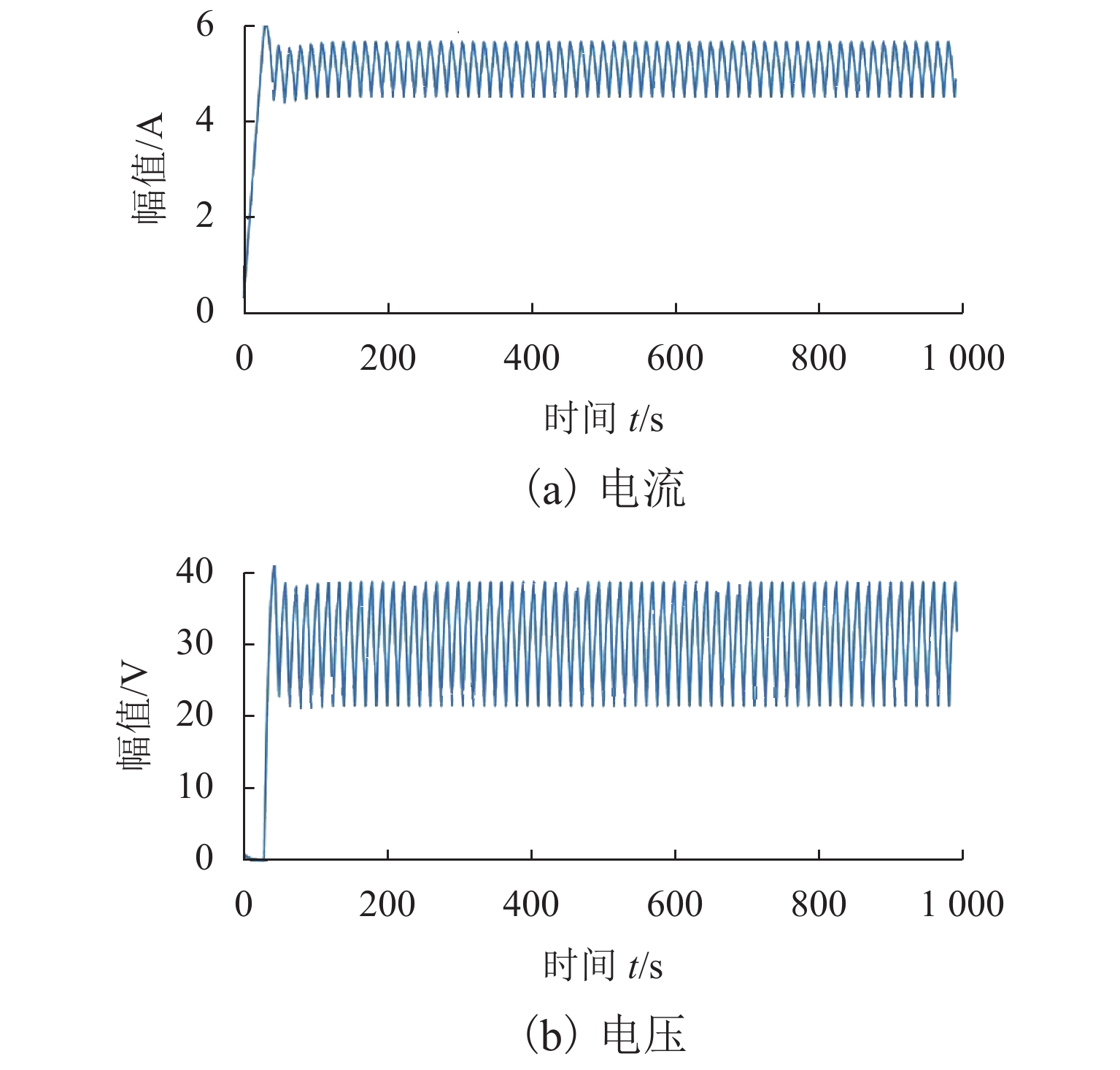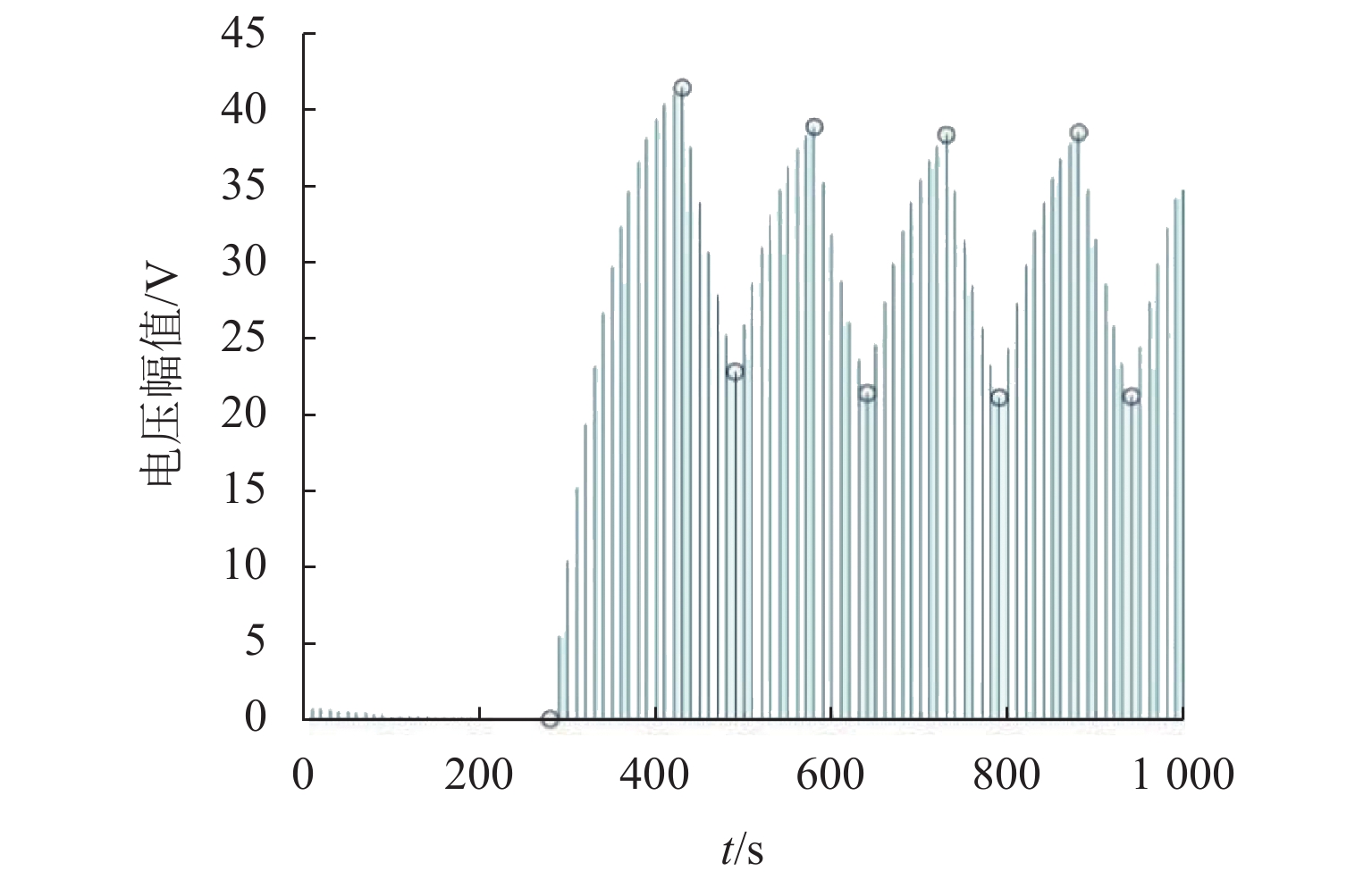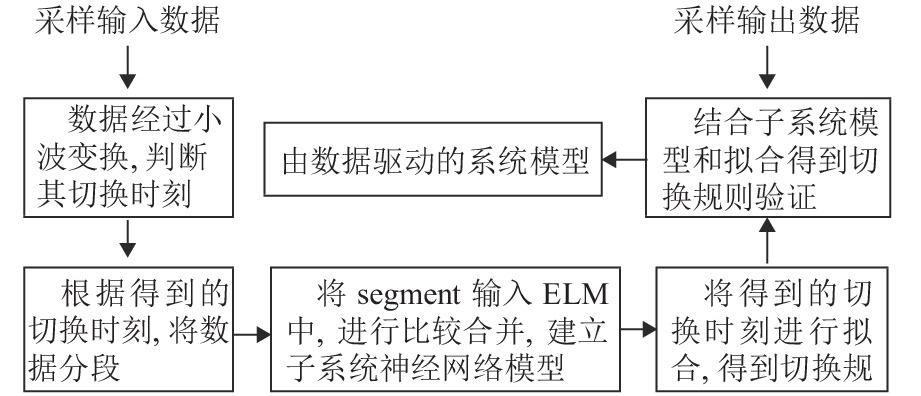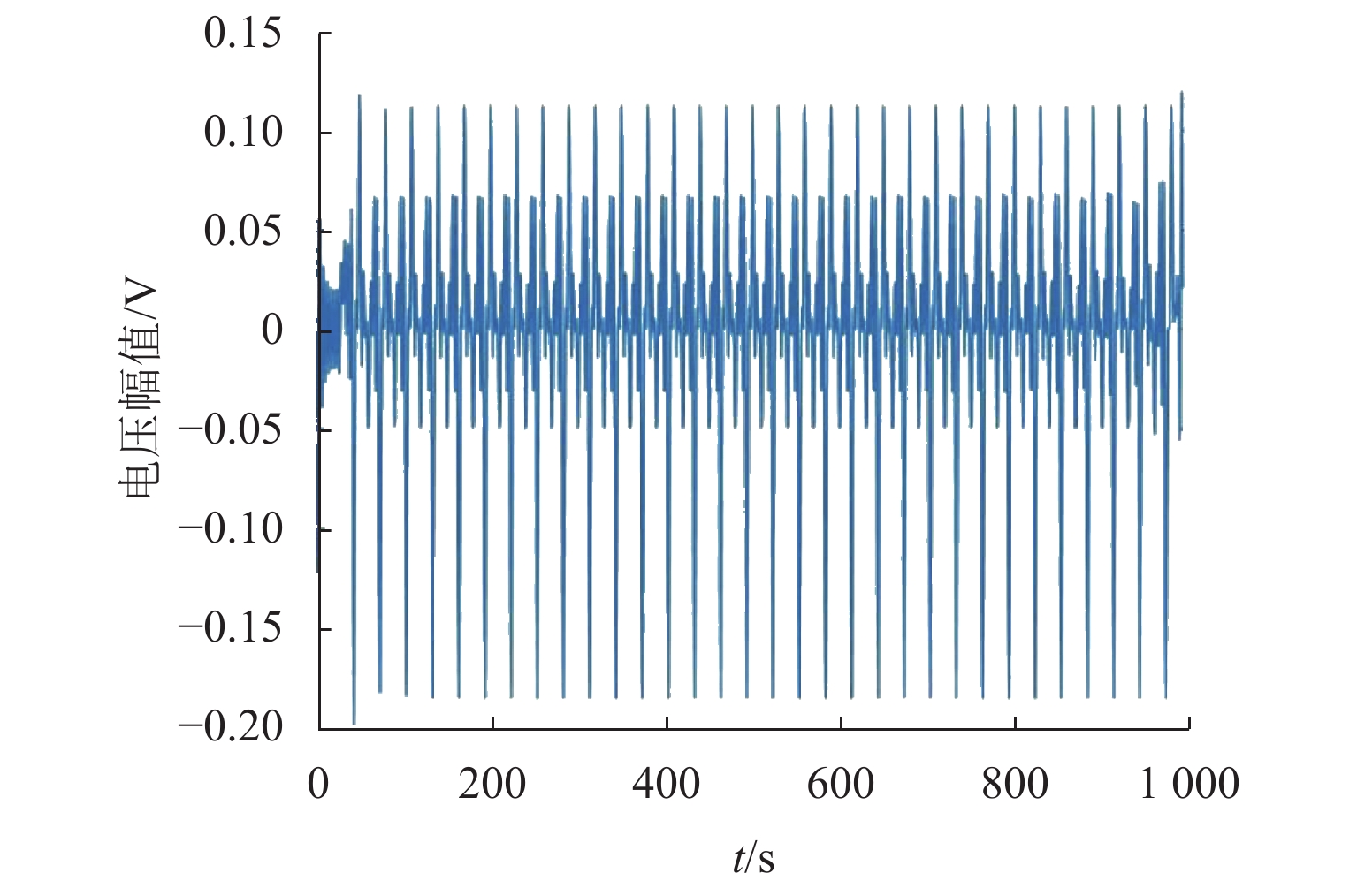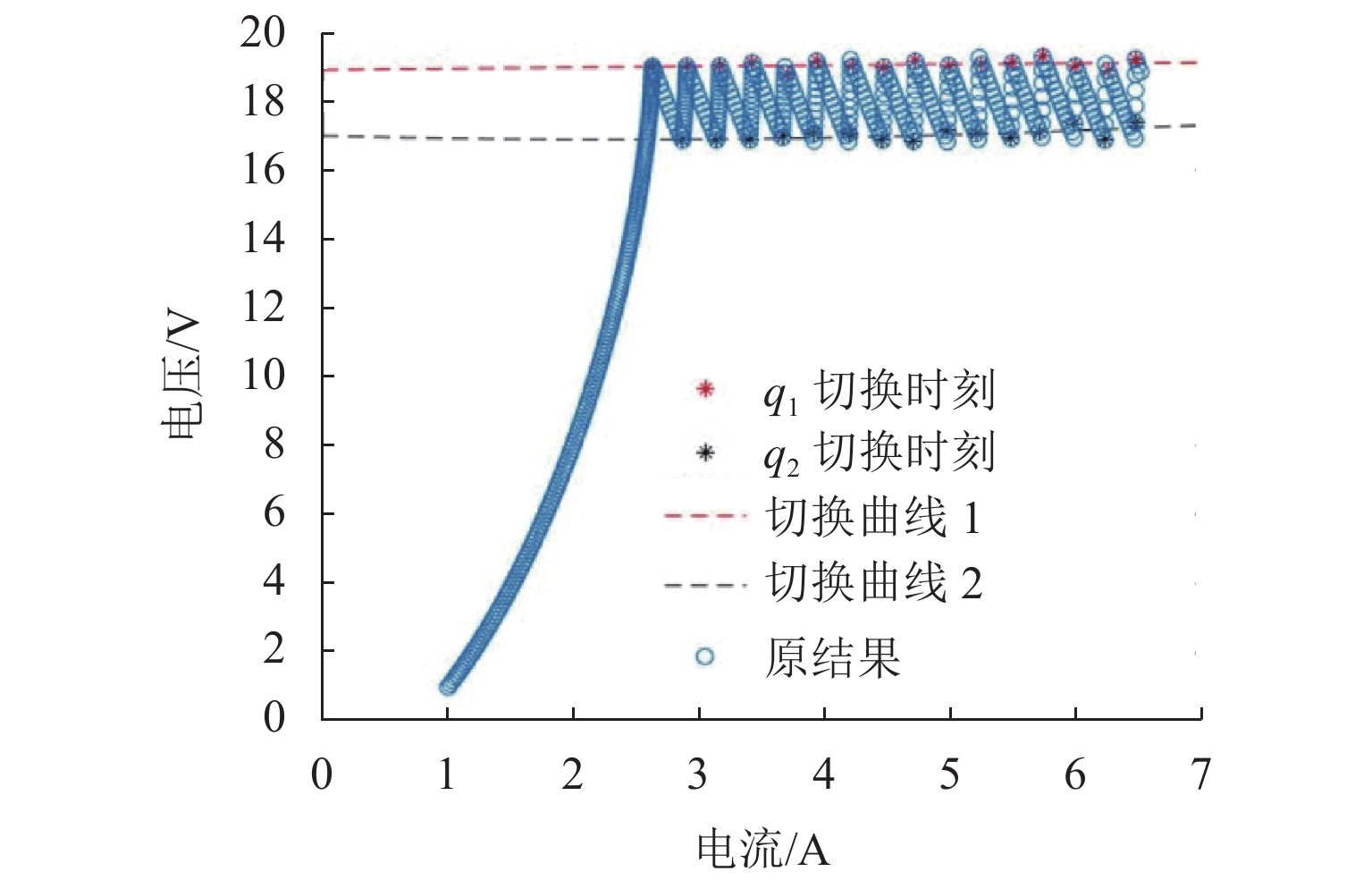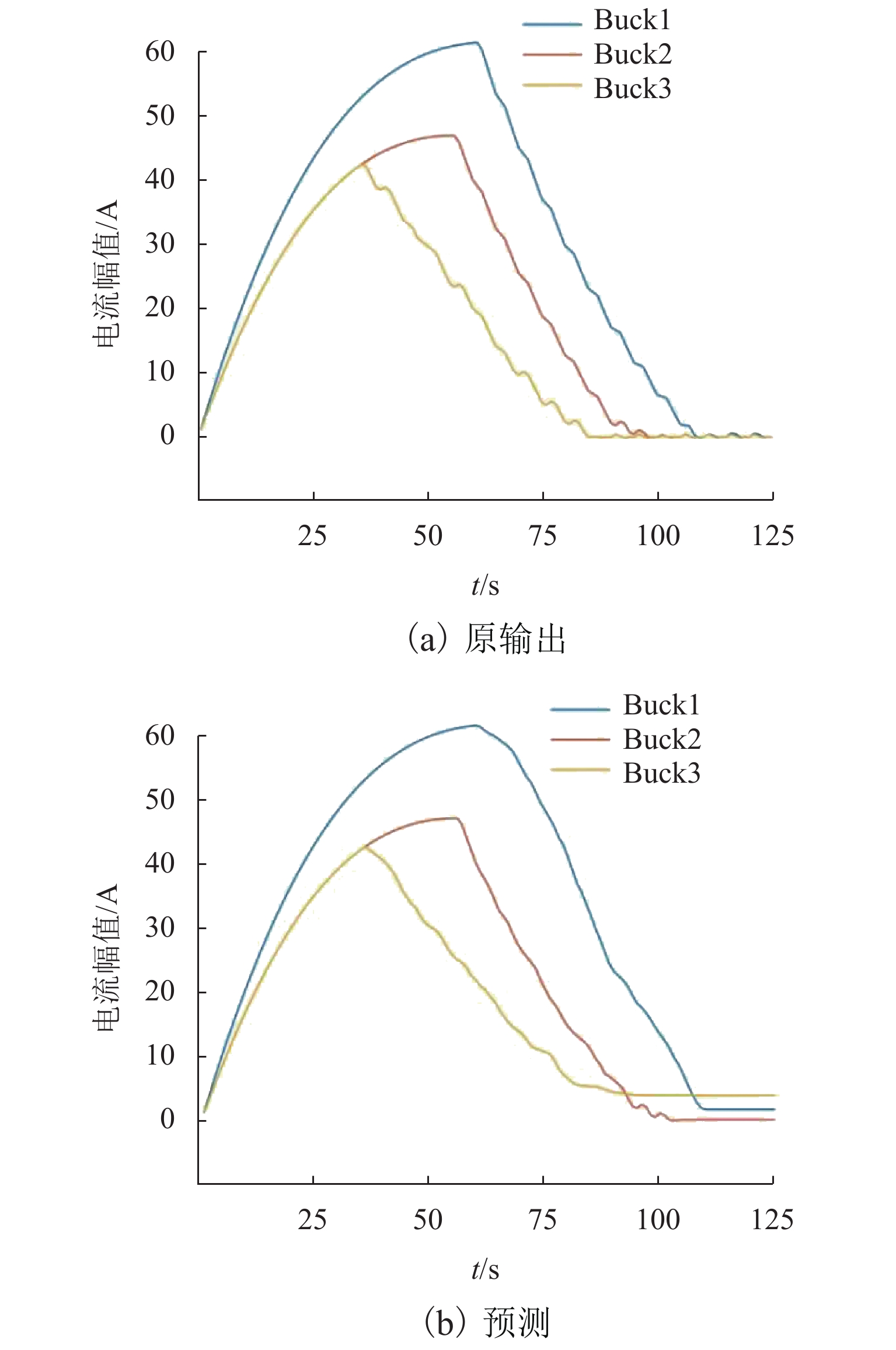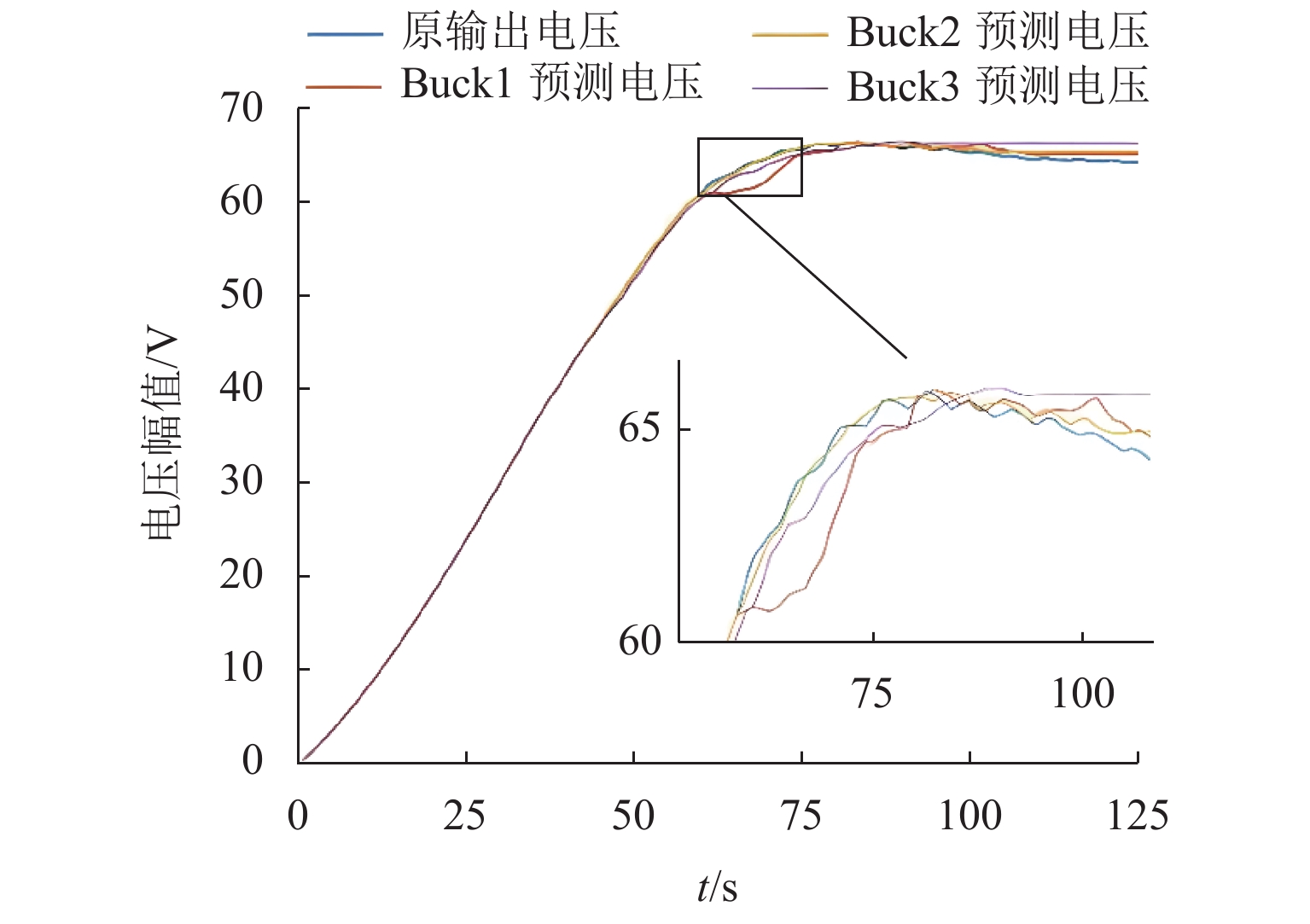Modeling of State-Dependent Switching System Based on Data-Driven
-
摘要:
切换系统是由一系列连续或离散的子系统和切换机制组合而成的一类复杂系统,状态依赖型切换系统因其复杂性而尚未被深入研究. 因此,通过系统的输入输出轨迹来对状态依赖的切换系统进行数据驱动建模,利用数据挖掘技术寻找数据之间的有用信息,建立输入与输出之间更形象的表达形式;在此基础上提出一种结构框架,根据辨识轨迹的切换时刻将数据分段,借助神经网络建立子系统的模型以及切换规则,深度挖掘状态依赖切换系统的信息,得到切换系统中子系统及子系统间的信息. 实验结果表明:相比传统的机理建模,本文提出的数据驱动方法将建模的复杂度降低了17.3%.
Abstract:A switched system is a class of complex systems that integrate a series of continuous or discrete subsystems and switching mechanisms. State-dependent switching systems have not been studied in depth due to complexity. Therefore, the modeling of state-dependent switching systems is explored through the input-output trajectories of the systems. The data mining technique is used to find useful information between data and establish a more specific and explicit representation between inputs and outputs. On this basis, a framework is proposed to segment the data according to the switching time of the identified trajectory, build the subsystem model by neural network to fit its switching rules, deeply mine the information of the state-dependent switching system, and obtain the information between the subsystems and subsystems in the switching system. The experimental results show that compared with the modeling of traditional mechanism, the proposed data-driven method reduces the modeling complexity by 17.3%.
-
Key words:
- state-dependent switching systems /
- data-driven /
- data model /
- neural network
-
切换系统指离散事件系统和连续变量动态系统两者相互作用的系统,是一种离散情况和连续情况相融合的系统,其特点是既随时间连续变化,又受离散突然事件的驱动,使系统的运行轨迹整体上呈现离散位置的迁移,局部上呈现连续系统的渐进演化,表现出十分复杂的动态行为. 切换系统涉及的领域广泛,遇到的问题复杂多样,很难找到一个通用的模型来描述. 大都采用常微分方程来描述系统连续部分特性,用离散事件模型来表示系统离散部分特性,这些方程既包含线性,也包含非线性,对复杂的系统来说,非线性的比例占比较大,甚至全部为非线性,加大了研究分析的难度[1].
切换系统的特点是每个运行模态下,局部连续动态受连续(离散)时间驱动的连续变量动态系统演化影响,条件满足时,激活运行模态转移事件,模态转移事件的激活条件由系统连续状态描述,而离散状态的变化又影响连续变量所服从的动态规律. 难以建立确切的模型对切换系统的特点进行描述和控制,因此,需要探索新的研究分析方法[2]. 对于时间依赖型,系统随时间而变化,故主要关注时间,常考虑Lyapunov函数方法等来对其进行分析. 对状态依赖型,系统根据其状态不断变化,受上一秒状态影响,呈非线性变化.
目前,常用的模型有自动机模型[3]、混杂Petri网模型[4]、混合动态模型[5]等, 这些模型广泛应用于多种场合,但在面对复杂的情况时表现仍然保守,有待深入研究这一系列模型[6-8]. 基于数据驱动下的模型能很好描述复杂的大型切换系统. 该模型更加准确且在高维度上对其进行分析,更重要的是能作为一种独立工具来使用. 进一步,该方法允许独立的仿真、测试、调试以及验证,很大程度上克服了机理模型的不足. 对于切换系统和复杂大系统来说,通过本文介绍的方法能准确地建立模型以及切换规则,实现对系统的还原以便测试及应用. 该框架建立数个子系统模型,适用连续系统和离散系统,同时也能可视化系统是如何切换工作的.
实际中许多系统难以构建准确的数学模型,只能获得输入输出数据,理论上,神经网络能准确描述系统,因此,利用神经网络对系统进行建模. 使用极限学习机(ELM)来对子系统进行建模,考虑其训练速度优于其他机器学习算法,并且有着良好的泛化性能,不仅能对数据进行拟合,同样也能对数据进行分类,目前已经存在这部分内容的研究[9-11].
本文利用神经网络从输入输出轨迹中提取未知切换系统的子系统个数、模型以及切换规则. 考虑这样一个状态依赖切换系统——DC-DC电路. DC-DC变换器的每个工作模态可看作是切换系统中的子系统,开关器件使系统在不同的子系统之间切换工作,变换器的工作模态会随工作条件变化而改变,工作过程中发生模态间的转换,故可将DC-DC变换器视为一类拥有不同子系统,且在不同子系统间工作的切换系统.
在采样输入输出轨迹的基础上完成了该框架,建立框架过程中对切换时刻进行辨识、将数据划分成段建模以及拟合切换规则[12].
对未知系统建模一直都是重点研究的方向,其往往要求较高的数学基础和分析能力,现有方法大多还是基于数学机理来建模和构造切规则,增加了对状态依赖切换系统的建模难度. 故本文提出一种框架,从生成的数据入手,不再使用传统的复杂数学方法,降低了对状态依赖切换系统的建模难度.
1. 启发性案例
对DC-DC系统来说,其子系统作用器件呈连续动态变化,在子系统切换时呈离散状态,是一个标准的切换系统. 来自电流状态依赖切换的DC-DC电路轨迹如图1所示,电路运行时子系统根据开关状态切换.
通过提取状态依赖下未知切换系统的子系统模型,并拟合子系统的切换规则,实现对状态依赖下未知切换系统的建模.
图2描述了DC-DC电路的切换过程,q1和q2分别为电路运行时的2个模型,即2个子系统;状态1和状态2为2个子系统对应的状态切换条件,状态1表示当电流大于5.5 A时切换到子系统2工作,状态2表示当电流小于4.5 A时切换到子系统1工作,满足切换状态条件则子系统发生切换. 通过对图1得到的输出轨迹进行采样,应用本文提出的框架还原图2过程,该框架能实现以下行为:1) 提取切换系统的切换时刻;2) 辨识系统的子系统个数,通过神经网络对其建模,并能在建立的子系统模型下稳定运行;3) 根据输入输出迹线及对应的切换时刻,挖掘子系统间的切换规则,实现不同子系统模型间的切换,整个系统能稳定运行.
2. 问题定义
2.1 输入输出迹线
考虑到实际系统往往难以获得准确的数学描述,但输入输出轨迹却是可测的,因此,考虑通过分析输入输出数据来挖掘系统更深层次的信息. 基于数据驱动来分析系统的方法不仅涵盖了系统的全部信息,同时也是最简单有效的. 首先对获得的轨迹数据进行采样定义:
定义1 采样轨迹
信号S的采样轨迹sw为具有时间戳和对应状态值的有限序列(t1,v1),(t2,v2),⋯,(ti,vi),⋯,(tp,vp):
1) ti<ti+1,ti∈R+,∀i∈[1,p],严格单调;
2) ti−ti−1=c,∀i∈[2,p],c为采样间隔;
3) vi∈D(s),∀i∈[1,p],D(S)为信号S采样的对应状态值的取值范围;
4) sw,i+1=f(sw,i),∀i∈[1,p],f(·)为系统的映射关系,sw,i为时刻ti采样轨迹sw的值,上一步的输出作为下一步的输入.
sw的子轨迹为sw(ta,tb),ta为起始时间戳,tb为终止时间戳.
如图3所示,对信号S按照定义1中采样得到sw,并观测到输出电压,根据不同电压状态值切换,并逐渐趋于稳定. 图3中,采样点上方有圆圈的时刻即为切换时刻.
定义2 输入输出轨迹
在定义1的基础上,给定一组输入信号I和输出信号O,输入输出轨迹sI,O是一组有限的数组矩阵:
sI,O=((ti,uI,i),(ti,μO,i)), (1) 式中:uI,i为输入信号在时间ti时的采样值矩阵, uI,i=(u1,i,u2,i,⋯,un,i);μO,i为输出信号在时间ti时的采样值矩阵, μO,i=(μ1,i,μ2,i,⋯,μn,i).
2.2 划分轨迹成段
对轨迹采样并划分成不同的数据段,每个数据段代表一个子系统描述,这样能更好地挖掘系统的输出关系,对后续描述切换系统也是至关重要的. 由于输入输出信号比较复杂,考虑到小波变换在图像识别中有很好的表现[13-14],因此,采取小波变换对信号状态变化进行分析,通过提取信号在频域中的特征辨识切换时刻. 利用小波变换具有边缘检测这一特性,可以得出,相比于时域,采样轨迹在频域中的表现形式更利于切换时刻的辨识. 通过提取轨迹的特征,能有效地识别出系统的切换时刻. 辨识得到的切换点能准确反映系统内部变化.
定义3 切换点
给定信号S的采样轨迹sw={(t1,v1),(t2,v2),⋯,(tp,vp)};
子系统的序号ow=1,2,⋯,n,n<p;
切换点πsw为具有时间戳的向量,是子系统切换的标志,如式(2).
πsw=(τ1,τ2,⋯,τk,⋯,τm), (2) τ则是一组有限的数组:
τ={(t1,v1,tx1,tow1),(t2,v2,tx2,tow2),⋯,(tm,vm,txm,towm)}, (3) 式(2)、(3)中:τ1为第一个切换信号,τm为最后一个切换信号,txm为整个系统第xm个切换点输入信号的时间,towm为进入子系统owm的时间, τk表示从子轨迹sw(τk−1,τk)过渡至子轨迹sw(τk,τk+1)时发生了明显变化,k∈[2,m].
用~定义2个轨迹的相似关系,故对某两段相邻子轨迹存在如下关系:
∀k1,k2<m:sw(τk1,τk1+1)~sw(τk2,τk2+1). (4) 如图3中给定的电压采样迹线所示,说明在2段轨迹之间发生了明显的切换,因此得到切换点:
πsw=(28,43,49,58,⋯,964,973,979,988). 定义4 段空间
定义为
∅:W→V, (5) 式中:W为所有采样轨迹的域,V为从轨迹中提取段的域,也称作段空间.
划分好的段为一个数组ψ=(sI,O,towm). 从图3不难发现,在28、43、49 s确定2个轨迹:sw(28,43)和sw[43,49],ϕs为均方误差,如式(6),代表每个段的特征,则有
{ϕs(sw(28,43))=0.9545,ϕs(sw(43,49))=0.0786. (6) 因此,段空间的数据段相似程度为
∅(sw(28,43))~∅(sw(43,49))<E, (7) 式中:E为设定的阈值.
当数据段的ϕs满足阈值E时,说明为同一子系统描述,数据段的相似判别将在第4节进行详细讨论.
根据以上定义,sw(28,43) 和sw(43,49) 间不存在相似关系. 因此,信号经过采样和切换时刻的识别处理后,再由段间合并分类算法辨识是否为同一子系统描述.
3. 结构框架及算法
在识别切换时刻的基础上,详细介绍段间合并分类算法的框架以及如何更好的优化. 本文方法框架流程如图4所示,对轨迹无特别的要求,对单输入单输出、多输入多输出信号都能准确地辨识. 通过对输入输出信号采样,根据采样信号执行图4中描述的步骤,对得到的信号进行分析处理,建立相应的子系统模型,在此基础上拟合子系统之间的切换规则.
3.1 辨识切换时刻
首先对输入信号检测采样,考虑在动态切换系统中的子系统之间发生切换时,系统的轨迹会出现比较明显的变化,有时出现十分明显的拐点,切换时刻往往在此时发生. 即开关管发出开通和闭合的切换信号,此时为切换点.
本文采用小波变换对系统的切换时刻进行辨识,将采样得到的输入电压经小波变换后结果如图5. 由图观测可得,采样信号在频域中存在大量阶跃时刻,特征最显著的即为切换时刻. 对小波变换得到的切换点πsw进行提取,可得128个切换时刻.
3.2 段间合并
提取切换时刻,将输入输出轨迹划分成段,根据辨识的切换点可假定DC-DC变换器在工作过程中会出现128个工作模态即数据分段. 在每个工作模态中,DC-DC变换器的工作情况都不相同,同时,每个模态也存在相似关系. DC-DC变换器正常工作时,工作模态在对应的条件下切换,因此,分段轨迹也是在不断的切换. 工作条件的关系研究将在后面进行讨论.
通过判断分段轨迹的相似关系,对段间轨迹合并和保留,使得同一子系统描述的分段轨迹合并,非同一描述则保留. 如定义4所描述,该合并过程与使用哪种具体类型的特征并无关系,且分段在段空间中满足一定的相似关系.
在定义4中指出,该方法主要关注段间关系及段间合并过程. 为具象化合并分类的过程,图6给出前100个输入输出轨迹采样和分段示意,流程如下:
1) 给划分好的每段轨迹按照切换时刻给定顺序编号(l=1,2,…,m + 1);
2) 对每段轨迹进行建模,即对每个工作模态建模,再根据定义4判断段间是否存在相似关系;
3) 将满足相似关系的两段轨迹模型合并再次训练,并对剩余分段按顺序重新编号,否则保留各分段模型;
4) 输出最终的子系统模型.
利用神经网络来完成段间关系讨论以及分段建模. 首先提取所有标号为1的输入输出段轨迹,并利用ELM进行训练建模. 为更好的讨论这部分内容,将补充:
定义5 分段输入输出
给定一组输入输出迹线,经过切换点的划分可得2组数组:
{sgI=(uI,i,ow),sgO=(μO,i,ow), (8) 式中:sgI为输入段,sgO为输出段.
在段空间中,提取出的轨迹输入输出sgI、sgO到ELM中训练,对应的模型为Em,对应的段输出为s∗gO.
因此,首先训练分段输入sgI1的子系统模型Em1,再将分段编号为2的分段输入sgI2给到子系统模型Em1,得到子系统模型Em1下的分段输出s∗gO2. 再将其与实际第二段轨迹分段输出sgO2比较,若满足定义4中的式(7),说明是同一描述,则合并两段轨迹,并重新训练得到新的Em1;若不满足,则保留模型Em1并对第二段轨迹训练建模Em2,同时将下一个编号段轨迹分别与Em1、Em2进行段间关系判定.
重复以上过程,不断地对段轨迹合并和保留,直至所有采样轨迹数据,最终输出系统的子系统模型.
根据切换时刻得到数个子模型,依次将Em1模型与Em2模型比较,是否满足定义4,若满足则合并得到E′m1,反之则保留并与下一个模型比较,不断合并最终得到2个子系统模型q1和q2.
3.3 切换规则拟合
对切换系统来说,最重要的就是子系统和子系统间的关系,即切换规则.
不同的切换规则会对切换系统产生完全不同的影响,如果切换规则选取合适,会提高切换系统的稳定,反之,就会给系统带来不良影响.
在以往的研究中,只要保证全部的子系统都有一个共同的Lyapunov函数,即可保证切换系统在任意的切换规则下稳定. 近年来,Lyapunov函数方法、多Lyapunov函数方法等都成为研究切换系统的主要方法.
本文通过数据驱动的方法来挖掘系统的信息,因此,仅从输入输出轨迹上来构建Lyapunov函数相对困难. 往往切换规则同切换系统一样是高维且复杂的,描述了变量在系统处于该状态下的响应,对状态依赖的切换系统来说,要保证建立的子系统模型在满足状态条件时切换. 因此,提出2种思路来对不同的切换规则进行拟合. 切换规则的选取至关重要,其影响着切换系统的稳定性.
3.3.1 最小二乘拟合
切换规则和切换平面往往是复杂且多变的,但有时也是容易观测的. 因此,针对这种情况,可采用最小二乘法对切换规则进行拟合.
每条切换规则的参数经过轨迹采样和切换点的寻找后,根据定义3可得切换时刻对应的系统状态值,其代表了不同子系统的工作条件. 因此,提取切换点πsw,选取电流、电压作为特征,对其拟合可得相平面图下的切换规则,如图7所示.
在切换曲线1下,系统由q1切换到q2工作;在切换曲线2下,则由q2切换到q1工作. 由图7可知,根据最小二乘拟合的切换规则,实现对电压依赖切换系统的控制,使子系统全部稳定,同时整个系统也趋于稳定.
3.3.2 神经网络拟合切换规则
通常采用机理建模的方法来推导拟合高维且复杂的切换规则. 由于该切换规则一般具有强非线性,因此,机理建模的方法在处理这类问题上是十分复杂的.
利用最小二乘法能对线性的切换规则进行良好的拟合,但随着切换规则复杂性的提高,最小二乘法拟合非线性切换规则非常困难,此时该方法拟合得到的切换规则难以满足子系统间的切换关系.
考虑到神经网络在理论上能任意逼近任何的非线性函数,具有准确拟合函数和学习能力. 因此,利用神经网络可以在复杂的动态系统下拟合出切换规则,同时也能在系统信息未知的情况下获得准确的结果.
通过采集已辨识的切换时刻,获得πsw并进行训练,拟合得到子系统间的切换规则. 将切换时刻的状态值与对应的子系统编号对应训练,建立切换规则模型. 有效解决了传统方法在切换规则拟合中存在的模型构造难、还原精度不高等问题,且初步探讨了神经网络在切换规则拟合中的应用.
如图8所示,当预测的切换信号达到切换时刻的值时,说明此时系统切换到另一个子系统进行工作. 观察图8可以发现,预测的信号不仅存在准确的子系统序号,同时也存在过渡信号,我们认为此时系统将保持上一个切换时刻,直至下一个切换时刻.
4. 实例研究
根据提出框架的流程,通过提取系统的输入输出轨迹,不论是仿真设计还是实际存在的系统,都能利用该框架帮助建模. 此外,将借助MATLAB验证所提出的方法.
4.1 DC-DC电路模型
基于DC-DC电路模型(案例1),存在2个输入:电流和电压,输出同样也是电流和电压.
为验证本文提出框架的正确性和合理性,通过电路的状态空间输出随机初始值的10条迹线,每条迹线数据为990个,共计9 900个输出数据. 这些轨迹涵盖了输入输出、基本的状态排列和系统信息. 根据第3节中提出的方法对切换点πsw进行辨识,提取出切换时刻状态值,并依此划分段空间. 通过在图4中概述的框架来完成合并,同时对子系统进行建模. 根据提取的切换时刻,对应不同的方法对切换规则拟合,输出切换信号曲线. 故该框架的最后输出是对系统从属的子系统模型(此案例为2个子系统模型)以及不同子系统间的切换规则.
为验证该框架建立的子系统模型和切换规则在面对除训练跟踪之外的其他跟踪同样能产生正确输出,将给定随机的初始值,还原一条迹线并与状态空间生成的迹线比较. 因此,给定该框架的模型和切换规则,任意的一组输入电流和电压经过训练模型和切换规则后,相同输入的状态空间输出迹线进行比较.
同样输入下的状态空间输出与所提出框架建模的输出进行对比,如图9所示. 输出电流和电压与测试输出的结果基本一致,预测结果基本还原了整个系统的信息,其均方根误差为3.414 55,最小误差为0.137,最大误差为5.540. 案例1的结果说明,通过数据驱动的方法可以得到子系统模型以及拟合出不同子系统之间的切换规则,实现对这个切换系统准确、完整的描述.
同时根据图9,可以发现提出框架得到的系统输出趋于稳定,逐渐收敛,电压收敛于25~43 V,电流收敛于4.5~5.5 A.
根据实验,需要系统提供一定的轨迹数才能保证较好地挖掘系统信息,这与采集得到的轨迹是否涵盖了原系统的信息有关,当信息采集正确且足够时,便可以对系统进行很好的还原. 在仿真验证过程时,提取了多条曲线来训练.
4.2 多端口DC-DC电路模型
在5.1节基础上,将3个Buck电路(Buck1、Buck2、Buck3)输入并联输出串联,并通过比例-积分(PI)控制其开关信号. 3个电路之间相互作用影响,是一个典型的混杂切换系统(案例2).
对上述系统分别采集3个电路的输入输出信号轨迹,每个Buck电路的输入输出迹线都为2个输入2个输出(电流、电压). 首先,经由第4节提出的方法判别切换点πsw,根据切换时刻划分段空间;接着,通过图4概述框架的后半部分完成对段轨迹的相似关系判定以及拟合切换规则;最终输出子系统模型以及切换规则.
与案例1相比,对3个Buck电路采集得到的输入输出轨迹分别应用设计框架进行处理. 由于每个Buck电路存在2个子系统和2个切换规则,因此,整个电路可得到6个子系统模型以及切换规则. 将案例2的电路拓扑结构整体替换,用神经网络拟合得到子系统模型代替电路元件,仅保留外部输入电源,同样对控制信号替换为拟合的切换规则,使用切换规则输出信号代替PI控制的控制信号.
给定替代后的电路随机输入电流和电压,根据本文的切换规则得到的预测结果如图10和图11所示. 由图10和图11可以发现:对于电路的输出电流结果基本一致,包括输出幅值和变化趋势;电流先上升再下降,最后收敛于0,电压逐渐收敛于65.0 V左右,此时预测结果仍十分接近,电压的预测结果与实际输出几乎一致.
根据对比结果可以发现,考虑到原系统的复杂性,本文所提出的框架仍然较好地完成了对原系统的还原预测,说明该方法是行之有效的.
5. 结 论
本文提出一个通用框架,通过对未知的混杂切换系统的输入输出轨迹推断其子系统个数、模型以及拟合切换规则,概述了该框架与方法的推理及迭代流程,并进行实例验证,证明了该方法的有效性以及通用性. 虽然这2个案例不能代表所有混杂切换系统的情况,但可以不断地对本文的框架进行更新与修改,提高其实用性以及准确性,以适应各种不同的混杂切换系统. 后续的工作中可以继续优化数据预处理,进一步研究和解决误差产生的原因,提高合并的准确性,采用更加准确的切换规则,同时,将在后续的工作中完成对建立模型的安全性验证,增强建模精确性.
-
-
[1] 郑刚,谭民,宋永华. 混杂系统的研究进展[J]. 控制与决策,2004,19(1): 7-11,16.ZHENG Gang, TAN Min, SONG Yonghua. Research on hybrid systems: a survey[J]. Control and Decision, 2004, 19(1): 7-11,16. [2] 程代展,郭宇骞. 切换系统进展[J]. 控制理论与应用,2005,22(6): 954-960.CHENG Daizhan, GUO Yuqian. Advances on switched systems[J]. Control Theory & Applications, 2005, 22(6): 954-960. [3] SHOHAM S, YAHAV E, FINK S, et al. Static specification mining using automata-based abstractions[J]. IEEE Transactions on Software Engineering, 2008, 34(5): 651-666. doi: 10.1109/TSE.2008.63 [4] GUDIÑO-MENDOZA B, LÓPEZ-MELLADO E. A modeling methodology for designing agents networks using timed hybrid Petri nets[J]. Simulation, 2017, 93(4): 323-333. doi: 10.1177/0037549716687835 [5] WANG R R, ZHOU J, JIANG H, et al. A general transfer learning-based Gaussian mixture model for clustering[J]. International Journal of Fuzzy Systems, 2021, 23(3): 776-793. doi: 10.1007/s40815-020-01016-3 [6] LIN H, ANTSAKLIS P J. Stability and stabilizability of switched linear systems: a survey of recent results[J]. IEEE Transactions on Automatic Control, 2009, 54(2): 308-322. doi: 10.1109/TAC.2008.2012009 [7] ZHANG Q, WANG Q J, LI G L. Switched system identification based on the constrained multi-objective optimization problem with application to the servo turntable[J]. International Journal of Control, Automation and Systems, 2016, 14(5): 1153-1159. doi: 10.1007/s12555-015-0057-4 [8] GARULLI A, PAOLETTI S, VICINO A. A survey on switched and piecewise affine system identification[J]. IFAC Proceedings Volumes, 2012, 45(16): 344-355. doi: 10.3182/20120711-3-BE-2027.00332 [9] HUANG G B, ZHU Q Y, SIEW C K. Extreme learning machine: a new learning scheme of feedforward neural networks[C]//IEEE International Joint Conference on Neural Networks. Budapest: IEEE, 2004: 985-990. [10] JI Y F, ZHANG S, YIN Y X, et al. Application of the improved the ELM algorithm for prediction of blast furnace gas utilization rate[J]. IFAC-PapersOnLine, 2018, 51(21): 59-64. doi: 10.1016/j.ifacol.2018.09.393 [11] YIN Y H, LI H F. Multi-view CSPMPR-ELM feature learning and classifying for RGB-D object recognition[J]. Cluster Computing, 2019, 22(4): 8181-8191. [12] 张斌. 切换系统的切换律及其输入u(t)整体最佳的设计方法研究[D]. 哈尔滨: 哈尔滨工程大学,2018. [13] TCHIOTSOP D, SAHA TCHINDA B, TCHINDA B, et al. Edge detection of intestinal parasites in stool microscopic images using multi-scale wavelet transform[J]. Signal, Image and Video Processing, 2015, 9(1): 121-134. [14] REIN S, REISSLEIN M. Scalable line-based wavelet image coding in wireless sensor networks[J]. Journal of Visual Communication and Image Representation, 2016, 40: 418-431. doi: 10.1016/j.jvcir.2016.07.006 -






 下载:
下载:











 下载:
下载:












